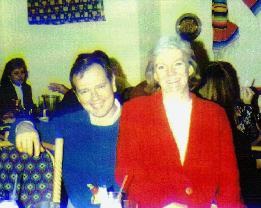48-Year-Old Steel Worker Embraces Dr. Sugarbaker's Tri-Modal The
On February 23, 1998, Tony Buszinski sought emergency care for a progressively sharp pain in his right chest from the Mercy Hospital in Pittsburgh, Pennsylvania. For the previous few weeks he was feeling tired and run down. He thought it was a simple chest cold at first. The ER doctors ordered chest films and discovered a very large pleural effusion. Tony was a healthy 48-year-old family man with a bright future.
His doctors immediately drained the fluid through an 18 gauge needle. The fluid was so thick that the doctors had trouble draining all of it. On February 28th, Tony returned to Mercy where they inserted a chest tube and removed nearly a gallon of fluid. The cytology was inconclusive, but the pathologist's differential diagnosis included mesothelioma.
Tony was then admitted to Mercy for further diagnostic testing. On March 5, 1998, doctors at Mercy performed a right-sided video assisted thoracoscopy. A talc pleuradesis was also performed. Several specimens were extracted and sent to pathology. The diagnosis was malignant mesothelioma of the pleura, biphasic type. Tony and his wife Nancy were advised that this was a rare and incurable tumor that was caused by asbestos. They scoured the Internet and found this website. They soon learned of Dr. David Sugarbaker, one of the world's leading surgical oncologists for mesotheliotics.
On March 30, 1998, the Buszinski's traveled to Boston, Massachusetts and met with Dr. Sugarbaker at the Brigham and Woman's Hospital (BPH). After undergoing various tests, including a quantitative VQ scan, Dr. Sugarbaker determined that Tony was a prime candidate for his tri-modal therapy (extrapleural pneumonectomy, intrapleural chemotherapy and post operative radiation).
On April 6, 1998, Dr. Sugarbaker performed the extra pleural pneumonectomy (EPP). The surgery lasted approximately six and one-half hours. Tony was hospitalized for the next six (6) days. The fourth day post surgery, his epidural was removed. At that point, when the pain medication wore off, Tony became painfully aware of just how much of his body had been cut, scraped, tied and eviscerated. He recalled that "it was impossible to get comfortable -- no matter which way I turned, I was met with a sharp pain." He was only able to sleep for three (3) to four (4) hours at a time before the pain would awake him. He remembered that he spent most of his waking hours wanting for Percocet. "I could feel every incision, every stitch, deep into my chest."
On April 12th, seven days later, Tony was discharged and remained in Boston until April 17th. The Buszinskis are presently at home and are scheduled to return to Boston on May 22 for their first follow-up appointment. At that time, Dr. Sugarbaker will discuss the chemotherapy regimen and follow up plan. Mr. Buszinksi understands that he is not out of the woods and his future will now revolve around a continuous stream of doctors, tests, drugs and hospitals.
Mr. Buszinski was exposed to asbestos products beginning in 1968. From 1968 to 1982, he worked as a maintenance welder at the United States Steel Mill in Homestead, Pennsylvania. He worked on pipes, boilers and furnaces throughout the plant. Tony was a member of the United Steel Workers of America, Local1397.
While Tony was hospitalized in Boston, Nancy was constantly at his side. She ignored the posted visiting hours - nothing was going to keep her away. She is now his "at-home nurse." She helps him get dressed, puts on his socks and ties his shoes. Tony is a deeply independent man and has had to adjust to relying so much on his wife. He has attempted to go back to work (in a clerical capacity) but finds the simple act of reaching for a pen both painful and exhausting. Tony's self-assessment is poignant: "my mind is willing -- bored, in fact, but the flesh is weak."
With the help of his wife and kids, his doctors, his church and his community, along with his own positive attitude, Tony is determined to bounce back.
** POSTED MAY 19, 1998 **
September 16, 1999
Tony Buszinski lost his seventeen month battle with mesothelioma on August 3, 1999. We remember Tony for his humanity and courage in the face of death.
Tony was a Habitat for Humanity kind of guy. He worked to do good for others. He helped build his church. After the church was built, Tony helped set up and operate its audio-visual equipment. He embraced his work, where he welded intricate and beautiful steel structures.
As the end neared, Tony asked that any friend who might want to send flowers at his service, instead should send a donation to the Mesothelioma Applied Research Foundation, (MARF). MARF is a not-for-profit corporation founded by Roger Worthington which aims to eradicate mesothelioma as a life-ending disease. Even in death, Tony did good. His wife, friends and Trey Smith, Roger's associate and Tony's trial lawyer, gave to MARF in Tony's memory.


